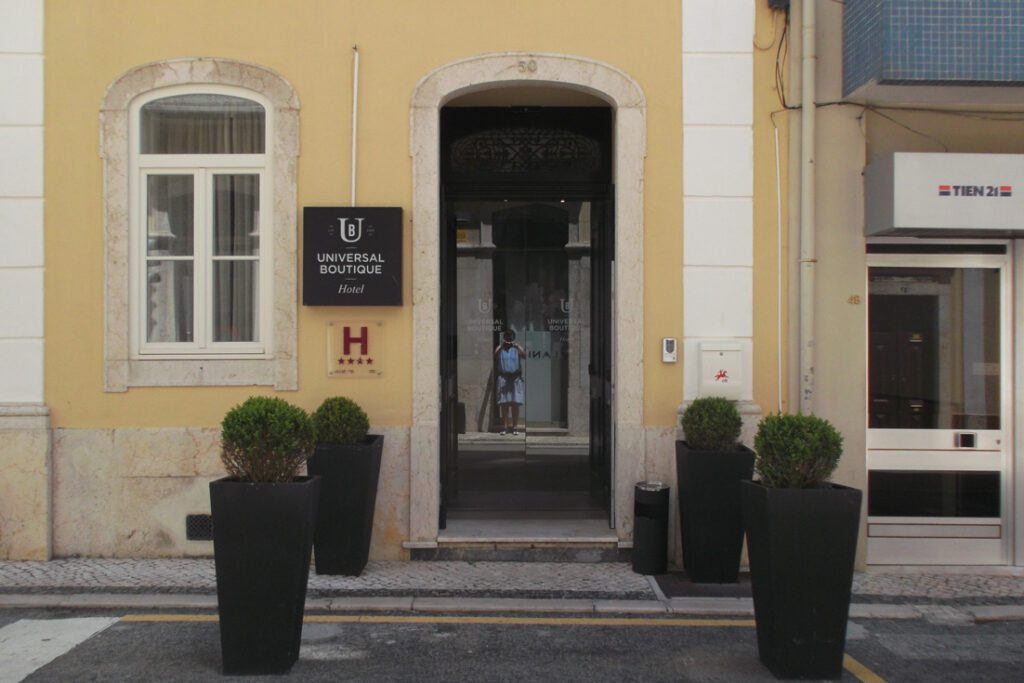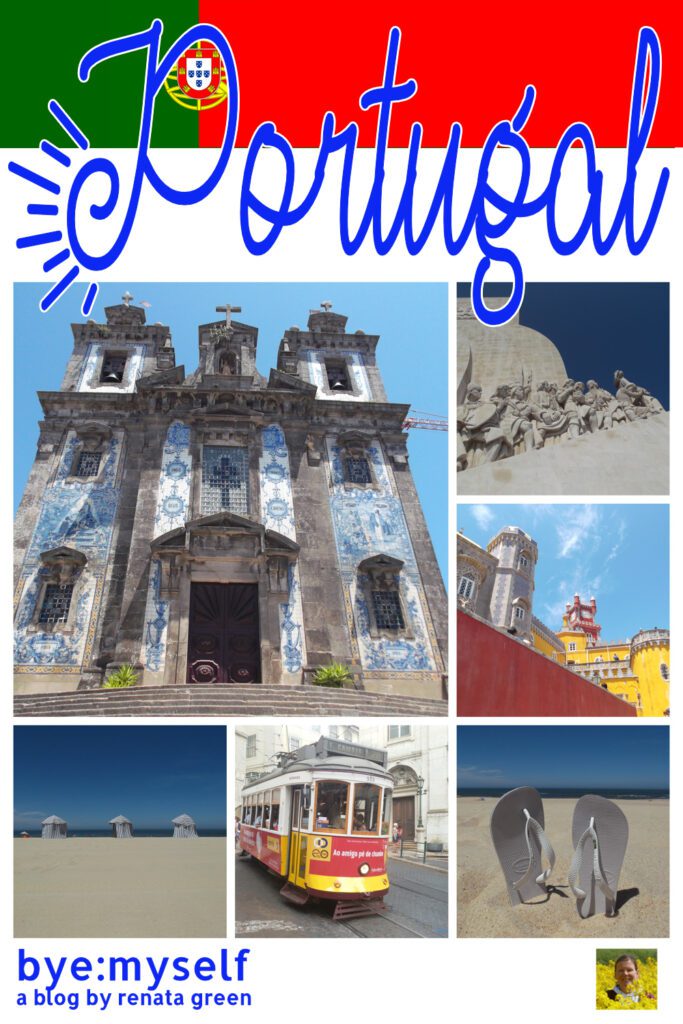On my railroad trip through Portugal, I experienced how travelling the country by train is easy-peasy, cheap, and fun.

Hence, let me guide you from mesmerizing Porto all the way south to Lisbon – with some amazing whistle stops in between.
Do you hear the whistle blow? Quick – jump on the train and let’s go!
Why Portugal
I must say that for decades, I haven’t been very interested in Portugal. I always thought it was a smaller, poorer version of Spain. Yes, that was very ignorant, indeed, therefore I’m only admitting this to you!
Nevertheless, twice I had to spend a day in Lisbon on a stopover and found it very charming. It even inspired me to my 24 hours in Lisbon-guide.
This being said, I need to point out that on my recent railroad trip, I became one of the country’s biggest fans under the Portuguese sun: Lovely cobblestone alleys and impressive architecture. Traditional Azulejos and cool’n’contemporary art. Hearty sardines and sweet’n’creamy natas. All this took me by storm – and I’ll be back as soon as I can to experience more of this small yet so varied country on the western shores of the Iberian Peninsula.
Portugal’s History in a Nutshell
The Moors, Muslim Berbers, and Arabs from North Africa invaded the Iberian Peninsula in 711, quickly taking control of most of present-day Portugal. For several centuries, the region was part of Al-Andalus, a prosperous Muslim territory known for its thriving cities, architectural advances, and cultural exchange. The influence of the Moors can still be seen in Portuguese place names, architecture, and even language.

However, Christian forces from the north began a long process of reconquest. By the mid-12th century, local Christian leaders started pushing the Moors southward, culminating in the formation of the Kingdom of Portugal in 1139 under King Afonso I. The Reconquista in Portugal ended in 1249 when the southern region of the Algarve was reclaimed from Moorish control.
Portugal’s Gilded Age
Following the Reconquista, Portugal entered a period of exploration and exploitation which is known as the Age of Discoveries. Under Prince Henry the Navigator’s patronage in the 15th century, Portuguese sailors began exploring the African coast and seeking new trade routes. In 1498, Vasco da Gama reached India, opening direct trade routes with Asia. Portuguese explorers also established settlements in Africa, South America, and Asia. In 1494, the Treaty of Tordesillas basically divided the world between Portugal and Spain.

Portugal’s vast empire brought immense wealth through the spice trade, gold, and other goods, making Lisbon a major European trading hub. However, the country’s global dominance began to wane in the 16th century due to competition from other European powers and the high cost of maintaining overseas colonies.
A major turning point in Portugal’s history occurred in 1580 with the death of King Sebastian I, who left no heir. Eventually, Philip II of Spain took the Portuguese throne, initiating a period known as the Iberian Union, during which the Spanish Habsburgs ruled Portugal.
Keeping Up With the Past Glory
In 1640, a revolt led by Portuguese nobles against Spanish rule restored Portugal’s independence, and the Duke of Braganza was crowned King João IV.

The Restoration of independence was followed by efforts to rebuild Portugal’s economy and restore its global significance. Portugal regained some of its lost territories, though it faced growing competition from other European powers. By the early 19th century, Portugal’s fortunes declined even more. The Napoleonic Wars forced the Portuguese royal family to flee to Brazil in 1807. In 1822, Brazil declared its independence, causing a severe blow to Portugal’s economy. In addition, the Portuguese Liberal Revolution of 1820 led to the adoption of a constitutional monarchy. All this left the country in a weakened state.
Under an Iron Fist
In 1910, Portugal became a republic after the assassination of King Carlos I in 1908. However, the First Portuguese Republic was characterized by political chaos, economic difficulties, and a series of short-lived governments. This instability eventually paved the way for the establishment of a military dictatorship in 1926. Eventually, António de Oliveira Salazar, a conservative economist, became Portugal’s prime minister and established the so-called Estado Novo. An authoritarian regime ruled Portugal for the following four decades. Salazar’s regime promoted nationalism and colonial expansion while severely repressing political opposition. Portugal held on to its African colonies despite growing international pressure for decolonization.

By the early 1970s, the Estado Novo was facing growing opposition due to its colonial wars and economic stagnation. In 1974, a peaceful coup known as the Carnation Revolution, overthrew the regime. The revolution was largely peaceful, with civilians offering carnations to soldiers as a symbol of peace. It marked the end of nearly five decades of dictatorship and led to the rapid decolonization of Portugal’s African territories. Nevertheless, apart from the mainland, Portugal also includes the islands of the Azores and Madeira, which lie far to the west in the Atlantic.
On Railroad Trips
I’m very much into cross-country trips. Since I’m not driving, I’m depending on public transportation which doesn’t only take me from place to place but also allows me to rub shoulders with locals and have a very authentic experience.
Therefore, get ready to encounter Portugal like never before as train travel here is the ultimate eco-friendly adventure! Imagine gliding through breathtaking landscapes, lush vineyards, and stunning coastlines—all while keeping your carbon footprint low! Forget cramped car rides or hectic airports. On Portugal’s excellent rail network, you’ll enjoy comfort, efficiency, and very budget-friendly fares. This isn’t just travel, it’s a journey through Portugal’s heart, with reliable and well-developed rail lines that let you sit back and savor every mile. The tracks are calling—are you ready to roll?
While a road trip by car takes you across the same country and landscape, you cannot enjoy marvelous views. You obviously cannot read a book or take a nap. All you can do is to risk a short glance at the landscape left and right. But just a really short one – and now: eyes back on the road!
I must admit that there are a couple of road trips by car that are quite sexy – like the legendary Thelma and Louise or classic Bonnie and Clyde.
At the same time, they tend to be more some sort of flight or escape, they have often something desperate and dangerous to them. They are rather races over the highway than meandering unhurriedly over rolling hills and through mellow valleys.
No wonder no car ever became a legend by a road trip. In contrast, think about the trains that make you all dreamy: The Trans-Siberian Express, the Orient Express, the Hirma Bingham – aaah, just mentioning their names takes you back in time when ladies used to travel in dresses and hats, taking all these chic travel accessories in leather trunks. Not light and handy, but definitely classy.
Practical Information
How to Get There And Around
By Plane
Obviously, since the country is located on the westernmost coast of Europe, you can travel to Portugal by train and even by long-distance bus – especially when you are coming from Spain or France. Yet, most visitors come by plane.

There are three international airports on the Portuguese mainland: Porto in the north, Faro on the southern coast, and, of course, Lisbon. However, there is also the Cristiano Ronaldo Airport on the island of Madeira as well as the João Paulo II Airport on the Azoren island of São Miguel.

These airports are served by regular as well as low-cost airlines and connect Portugal to destinations worldwide, making the country an easily accessible destination for international travelers.
In general, the airports are well connected to the city centers by public transport, so it is usually not necessary to take a taxi.
By Train
Travelling by train in Portugal is an eco-friendly choice, reducing your carbon footprint compared to car or plane travel. But train travel is also a scenic way to explore the country, offering comfort, efficiency, and affordable prices. The rail network is very well-developed and reliable.
There are various types of trains with the so-called Alfa Pendular being the fastest and most comfortable one. It offers free Wi-Fi, air conditioning, and onboard snack service. The so-called Intercidades are slightly slower, however, they are more budget-friendly but still offer comfortable seating and amenities.

Note that discounts are available for advance bookings, seniors, students, and young people under 25. Booking tickets online via the Comboios de Portugal’s website is highly recommended.
By Bus
Traveling by bus in Portugal is a convenient and far more affordable option. Buses don’t only connect major cities, they also go to many smaller towns that may not be accessible by train.
Portugal’s main long-distance bus companies Rede Expressos, FlixBus, Renex, and CitiExpress offer reliable and comfortable service. To give you an idea, the bus trip from Lisbon to Porto typically takes around 3 to 4 hours, depending on the service and traffic conditions. A one-way ticket ranges from 10 to 25 €uros, depending on the bus company, how early you book, and whether it’s a peak travel time.
Getting around Portuguese cities is easy and enjoyable, even more so without a car. Portugal’s public transportation system is well-developed, with metro networks in Lisbon and Porto offering fast, affordable travel across city centers and key attractions. Trams are iconic, especially in Lisbon, where the vintage yellow trams climb the city’s steep hills with charm. Buses run extensively in most cities, and trains connect nearby towns for seamless day trips. For shorter trips, many cities have bike and electric scooter rentals, perfect for exploring at your own pace. Walking is also a fantastic way to soak in Portugal’s historic streets and lively squares!
Where to Sleep
Portugal offers a wide variety of lodging options to suit every travel style and budget. You’ll find everything from luxury hotels and boutique stays in cities like Lisbon and Porto to charming, family-run pousadas and traditional quintas, hence, country estates in rural areas.
Booking.comFor a more budget-friendly option, hostels are widespread and often highly rated, offering a social atmosphere and central locations. Vacation rentals and guesthouses, known as alojamento local, are popular for a more local experience, especially in coastal towns and the Algarve. For a unique stay, you can also try glamping in nature or historic pousadas set in restored castles and monasteries.

Here you can choose the best one from all possible options according to your needs and budget*:
Booking.comWhat to Eat
Portugal is known for its seafood. Dishes like Bacalhau à Brás, a blend of shredded salted cod, onions, and eggs, are just fantastic. Other seafood must-tries definitely include grilled sardines, often served with roasted peppers and potatoes, and Polvo à Lagareiro, octopus roasted with garlic and olive oil.

Don’t worry, carnivores will also get their money’s worth in Portugal. Try Caldo Verde, a hearty soup made from kale, potatoes, and chouriço sausage. Or Cozido à Portuguesa. This is a boiled meat and vegetable stew that includes various cuts of pork, beef, sausages, and cabbage.
Small Snacks
Petiscos are the perfect choice, especially with a drink. Similar to Spanish tapas, these are small snacks that are often ordered to be shared among the entire party.

Bifanas, pork sandwiches spiced with garlic and paprika, are very popular local fast food. So are Bolinhos and Pastéis. These are potato-based deep-fried dumplings, typically combined with Bacalhau, hence, codfish. But they come also with other ingredients like ham, cheese, or veggies. This perfect snack is available basically everywhere.

Finally, the pastel de nata is a national treasure. It is a small custard tart with a creamy egg-based filling in a flaky, crispy pastry crust. These tarts were originally made in the 18th century by monks at the Jerónimos Monastery in the nearby city of Belém. The recipe spread throughout Portugal, but each bakery has its own interpretation of the pastry.

Also, don’t forget that Portugal is famous for its wines. Vinho Verde, a light, slightly effervescent white wine, is perfect for a warm day, while Alentejo reds are rich and full-bodied. While people from Porto swear by Superbock, the most popular beer in Lisbon is Sagres.
Visiting Organized
I’m an avid solo-travelling woman. Since solo-travel doesn’t equal solitude, I love to join organized tours here and there. They allow me to meet fellow travellers – for just a short moment or a lifelong friendship.
Therefore, here are some great ideas of what to do on your tour through Portugal. Pre-booking online will guarantee your place at the activity of your choice*:
Cash, Card, And Discounts
Until now, 20 European countries replaced their former local currency with the €uro starting in 2002. Obviously, Portugal is one of them. The exchange rate is 1 US$ = 0.94 EUR as of November 2024. However, you can check today’s conversion rate on this page.

Cards are accepted basically everywhere. Except, of course, at the small stands on the streets and at the market.
Most of the time, entrance fees in Portugal aren’t exactly neck-cutting, but it’s still worth saving a little here and there. And that’s where sightseeing passes come into the picture. In addition to free use of the usual means of public transport, they include free or highly discounted access to the most iconic landmarks and activities. This not only saves money, but also lots of time as you don’t have to queue every time you need a ticket.
Language
Did you know that Portuguese is the fifth most spoken language in the world? It is the official language in Brazil, Angola, Cape Verde, Guinea-Bissau, Mozambique, São Tomé and Príncipe, East Timor, and Portugal, obviously. In addition, Portuguese is spoken both in Macau, which was under Portuguese administration until 1999, and in Goa. What I find all the more surprising is how few visitors speak the language – compared to, for example, Spanish.
Speaking of which, if you speak Spanish reasonably well, you’ll be able to at least read Portuguese quite easily, and if Portuguese speak slowly and clearly, you’ll understand a lot, too. It’s a problem with speaking, because although Spanish – and Italian, and to a certain extent also French – and Portuguese are similar, they definitely are different languages. You shouldn’t assume that everyone will understand you if you just babble on in Spanish for the sake of simplicity. Furthermore, this is not very much accepted and often perceived as rude. If you want to use Spanish, at least ask at the beginning of the conversation if that would be okay.
I would also like to emphasize how many Portuguese – especially young people, of course – have an excellent command of the English language. Nevertheless, it is a gesture of respect to learn some basic vocabulary. Today this can be done quickly and easily with the help of language apps like Lingohut or Babbel.
Connection and Communication
Since June 2017, no roaming charges have applied within the EU with a European mobile phone contract. This applies to all 27 countries of the European Union as well as Iceland, Liechtenstein, and Norway. It pertains to all contracts.

When roaming is not available, you can connect to the internet in many public places free of charge.
You can get a SIM card if you insist on being online 24/7. For example, cards by LycaMobile start at 10 €uros. However, although the plan lasts for 30 days, keep in mind that it only includes 4 GB of data. Other recommendable providers are MEO, NOS, and Vodafone.
In Portugal, they use plug types C and F. Their voltage is 230 V and the frequency 50 Hz. Nowadays, as all these chargers have integrated adapters, in general, the voltage and frequency don’t really matter.
By the way, you’ll find comprehensive travel info in my post World’s Most Complete Travel Information – an indispensable globetrotter-classic.
Map
This is the route I travelled. Clicking on the slider symbol at the top left or the full-screen icon at the top right will display the whole map including the legend.
Places I Visited
The detailed information on each of my stops is found on these pages








Apart from the Portuguese mainland, I also enjoyed some island hopping on the Azores. Although this archipelago is located about 1,500 kilometers off the Portuguese coast, it belongs to Portugal.
Pinnable Pictures
If you choose to pin this post for later, please use one of these pictures:






Note: I’m completing, editing, and updating this post regularly – last in November 2024.
Did You Enjoy This Post? Then You Might Like Also These:
Best Street Art in LISBON – Part I: Graça And Beyond
ISLAND HOPPING in the AZORES
Best Street Art in LISBON – Part III: Moscavide
FAIAL – the Most Beautiful Island of the Azores
Guide to FIGUEIRA da FOZ – a Charmingly Old Fashioned Seaside Resort
What Not to Miss in TERCEIRA, the Azore Island of History and Grace
PICO – the Top of the Azores
24 hours in PORTO
* This is an affiliate link. If you book through this page, not only do you get the best deal. I also get a small commission that helps me run this blog. Thank you so much for supporting me!








